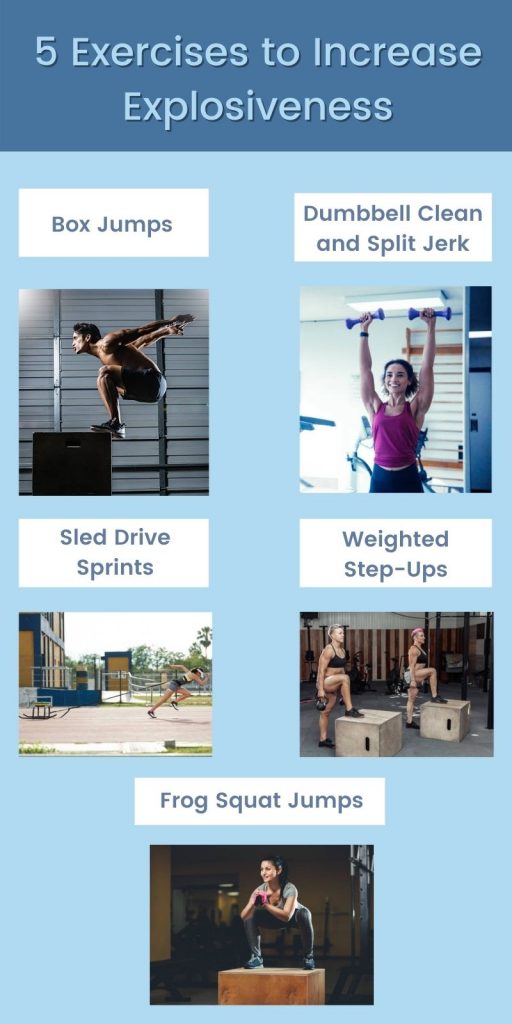Every single athlete, regardless of your specific sport or your level of fitness, should train for explosive strength.
Explosiveness refers to your ability to express a high amount of strength within a minimal amount of time. Examples include AMRAP rounds in a CrossFit box, or the 100-meter dash at every Summer Olympics.
But you don’t need to be a Crossfitter or an Olympian sprinter to experience the benefits of explosive training (sometimes referred to as “ballistic training”). These benefits include:
- Increased speed: Whether you’re jumping or running, explosiveness minimizes your ground contact time while maximizing your force, thus ramping up your pace.
- Increased agility: Explosive twists, turns, and rapid direction changes benefit you when you’re playing football or similar sports, as well as in competitive competitions like boxing and mixed martial arts.
- Increased strength: When you’re doing resistance exercises, strength gains come from muscle activation that stimulates your muscle fibers. Explosive muscle contractions activate the most muscle fibers in the least amount of time, making your general workouts and weight lifting more efficient and effective.
Example movements that require high levels of explosive strength include:
- Sprinting
- Leaping
- Jumping
- Throwing
- Punching
- Bounding
- Cutting
- Diving
- Rotating/twisting
- Juking
If you want to enhance your performance in these specific movements, you must train for explosiveness. In this guide, we’ll dive into the physiological and biomechanical aspects that influence your explosive strength. We will also share five best exercises to increase explosiveness.
How to Increase Explosiveness
Explosive strength requires an increase in both your speed strength and your absolute strength. There are a few fundamental physiological and biomechanical mechanisms that factor into this:
- Fast-twitch (type II) muscle fiber recruitment
- Improved rate coding (i.e., the rate that your brain sends messages to your motor units)
An overall improvement in absolute strength through traditional resistance training can contribute to explosiveness. But to really build your explosive speed, you must hone your body-mind connection and train your body to recruit more type II muscle fibers.
Fast-Twitch Muscle Fibers
Not all muscle is created equal. Without going too deep into the science of your musculature, your muscles can generally be categorized into two categories:
- slow-twitch type I muscle fibers
- fast-twitch type II muscle fibers
The former has a high aerobic capacity and a slower contraction rate. Your body uses these slow-twitch muscle fibers during long-distance or endurance events and when you’re performing aerobic exercise.
Fast-twitch muscle fibers are quite the opposite. They’re capable of faster contractions and can carry a heavier load. This gives them more anaerobic potential that your body uses when weightlifting, jumping, sprinting, and doing other high-intensity, short movements.
Rate Coding
A motor unit is a specific motor neuron and its connecting muscle fibers. A motor pool — a collection of coordinated motor units — is responsible for contracting a specific muscle in response to neural impulses from your brain.
Rate coding refers to the frequency that your neural impulses are fired, and your motor units are activated. By improving your rate coding, you increase both the speed and the amount of force created by your motor units.
Putting It All Together
When you’re exercising, playing a sport, or doing anything else that contracts your muscles and demands explosiveness, your body fires up your motor units starting from slowest to fastest.
The recruitment of your muscle fibers and activation of your motor units follows a complicated process but essentially boils down to two stages.
First, slow-twitch muscle fibers get recruited. When doing an activity like walking, these type I fibers may be enough, and your body won’t activate additional muscle fibers.
Should the demand on your muscles increase, either in terms of force, speed, or both (i.e., explosiveness), your brain sends a message to your fast-twitch muscle fibers and begins to activate them.
You get what you train for, and your body adapts best to the stress it’s put under on a repeated basis.
If you want your body to adapt and move past the first stage of muscle fiber recruitment to activate your type II muscle fibers, you must train your muscles to repeatedly go through these stages over and over again. Not only will this strengthen your type II muscle fibers, but it will also train your mind-body connection and improve your rate coding.
Any exercise that targets your velocity, starting strength, acceleration strength, and maximal strength will improve your explosive or ballistic power. The following five exercises do precisely that.
5 Exercises to Increase Explosiveness
1. Box Jumps
Box jumps are one of the most popular forms of plyometric rebounding exercises. All forms of plyometrics improve your explosiveness because they incorporate explosive, rapid muscular contractions at a high intensity, thus building your overall power, your starting strength, and your speed.
However, because of the high velocity involved in plyometric programming, you are at a higher risk of experiencing injuries. When doing box jumps, make sure you land on your full foot to help minimize the sharp impact on your foot and leg joints. And focus on staying balanced — twisting or torsion of your foot when jumping or landing from a jump can lead to sprains and strains.
Instructions:
- Select a box that’s approximately a foot off the ground to start (you can increase the box’s height as you build strength, balance, and confidence with this exercise).
- Face the box, positioning yourself approximately six inches away from the box.
- Stand with your feet slightly wider than your shoulders and your knees slightly bent.
- Bend your knees, push your buttocks backward, and swing your arms behind you.
- Rapidly straighten yourself up, exploding up from the ground while thrusting your hips forward and swinging your arms up.
- Jump as high as possible and land on top of the box.
- Step down from the box and repeat for three sets of five jumps.
2. Sled Drive Sprints
Unlike steady-state cardio, which recruits your slow-twitch muscle fibers, high-intensity sprints activate your fast-twitch, type II muscle fibers in your glutes, calves, and quadriceps. Sprint drills are beneficial for training your explosive acceleration strength, which you can then utilize in any other form of high-velocity movements.
While traditional flat sprints are useful, sled drives take it to another level by adding weighted resistance. The result: Improved neuromuscular activation, faster strength improvements in your lower body, and enhanced lengthening of your stride, which provides secondary speed benefits.
Instructions:
- Put on a sled harness around your waist and attach it to a weighted sled.
- Get into a sprint starting position, with one leg in front of the other in a lunge and your body leaning forward at a 45-degree angle.
- Explode forward, pushing off the ground with your back leg while maintaining your forward-leaning stance.
- Sprint as fast as you can while dragging the sled behind you.
- Advance for approximately 15 yards, then rest.
- Repeat six times.
3. Dumbbell Clean and Split Jerk
Many plyometric exercises and ballistic movements emphasize the lower body. This is natural because so much of your explosive performance comes from how successfully you’re able to drive off the ground with speed and force.
But many athletes will need to train for explosiveness in the upper body, especially when it comes to high-intensity turns, twists, jabbing, punching, ducking, etc. Dumbbell clean and split jerks are a powerful way to focus on this, emphasizing anaerobic performance while also enhancing your motor coordination.
Instructions:
- Stand with your feet shoulder-width apart.
- Hold a dumbbell in each hand. Rest the weights on your shoulders and keep your elbows extended forward and pointing in front of you.
- Bend your knees and drop down, then push up forcefully and land in a lunge position.
- Simultaneously push your dumbbells above you, extending your arms overhead.
- Step back into the starting position and lower the weights back to your shoulders.
- Repeat with the other leg. Aim for four sets of eight to 10 reps.
4. Weighted Step-Ups
Weighted step-ups are a great compliment to box jumps and are a bit more accessible for those who find full plyometrics too challenging. However, this workout mimics many of the same movements and incorporates explosive speed (but with less joint impact), so you’re still training those crucial fast-twitch muscles.
Your goal throughout these movements is to move as fast as possible, pushing off the ground as quickly as you can and rapidly returning to the starting position. By incorporating weights, you add resistance and build strength while also enhancing your motor coordination, mind-body connection, and balance.
Instructions:
- Face a box or bench with your feet hip-width apart.
- Hold a dumbbell in each hand, or hold a barbell across the back of your shoulders.
- Step up with your right foot, driving off the ground with speed and force.
- Bring your left foot up to meet your right foot so that you’re now standing on top of the box or bench.
- Bend your right knee and step down off the box with your left foot.
- Step up with your right foot.
- Repeat, alternating which leg you step up with at the start of each rep.
- Aim to do as many steps as you can in one minute.
5. Frog Squat Jumps
Traditional squats hone the maximal strength you need for explosiveness. Frog squats add in an additional emphasis on velocity and acceleration strength. Finally, throwing in a jumping movement targets your starting strength.
Throughout a frog squat jump, you’re training your body to switch quickly from slow contractions to fast, full-force contractions. This helps your body to adapt to rapid transitions between slow-twitch and fast-twitch muscle recruitment, which is foundational for explosiveness.
Instructions:
- Stand with your feet shoulder-width apart.
- Hold a single dumbbell between your two hands, hanging between your legs with your arms relaxed.
- Squat down, then explode upwards and forwards like a frog leaping forward.
- Land softly and go as low as possible so that the dumbbell touches the floor between your feet.
- Explode back up the moment the weight hits the ground.
- Aim for four sets of 12-15 reps.
Conclusion
To increase explosiveness, you must perform movements that incorporate explosiveness.
While all forms of resistance training can build strength and power, and all forms of aerobic, endurance exercises can improve your speed, it is the workouts that activate your type II muscles and improve your rate coding that will lead to the greatest improvements in explosive strength.
For the best results, keep your explosive training varied.
Research suggests that mixing up your workout so that you’re doing both heavy explosive exercises and light explosive exercises leads to the fastest results. This can be as simple as increasing and decreasing the weight you’re using during sled drives or weighted step-ups.
The above exercises are just the tip of the proverbial iceberg. You can even modify your traditional movements to focus on explosiveness. Whatever exercise you choose to do, always maintain speed and intensity while moving with explosive force instead of the long, slow movements you typically see in traditional exercise regimens.


